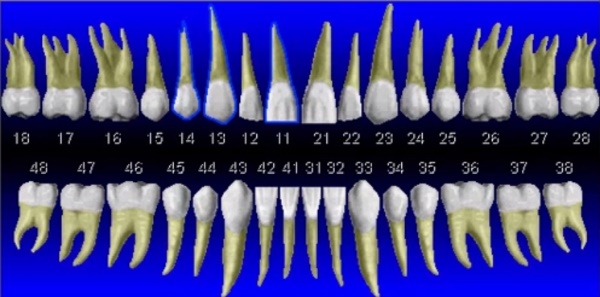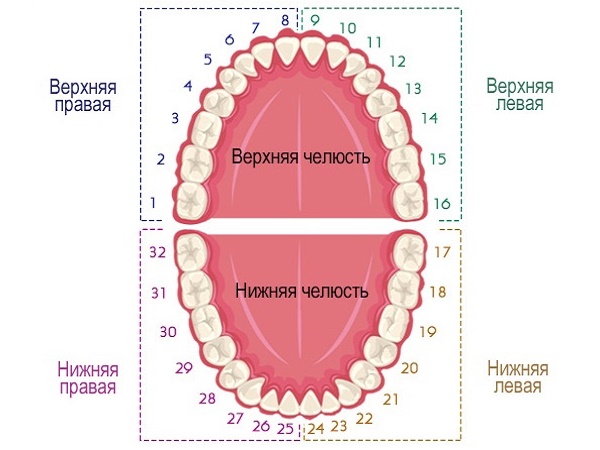For many people not directly related to dentistry and resorting to its services only in situations where the help of specialists is needed, medical terminology is a mystery that is not of particular interest.
A person does not delve into the interpretation of the professional vocabulary of doctors, considering it exclusively the prerogative of specialized specialists, however, without noticing it himself, he often experiences certain difficulties from such limitations.
You must admit that many are familiar with the story when, turning to the dentist with his problem, the patient cannot clearly formulate which tooth is bothering him, while using all his eloquence.
Any tooth in the international medical classification of definitions has been assigned a distinctive name that gives information about its specific location.
However, their use in everyday dental practice is inconvenient, since it complicates the doctor's work and distracts him from performing his direct duties due to the waste of additional time on the interpretation of special terms.
To simplify the wording, the names have been replaced by a system of numbers- this made it possible to simplify their names, as well as to specify the information about the state of the patient's oral cavity, reflected in his outpatient card.
Digital numbering minimized the time spent on its design, making the process of visiting the dentist more streamlined and functional.
Types and purpose of teeth
The defining task of the dentoalveolar organ is to ensure the processes of respiration, intake and chewing of food, and to ensure speech function.
Normally, each of the jaws has 16 teeth, each of which has its own appearance and individual purpose:
- incisors- are located in the central part, have a flat appearance, a sharp superficial cut and a single root process. Their goal is to make the biting process more comfortable;
- fangs- in the oral cavity, they immediately follow the lateral incisors, are distinguished by a strong crown and easily cope with biting off large pieces of food;
- premolars(small basal) - located next to the canines, their function is to thoroughly grind and chew food;
- molars(main chewing ones) - occupy the last places in the jaw row and provide the final crushing of food before the swallowing function.
More information about the purpose and structure of teeth is described in the following video:
Jaw segments
The jaw structure in international medicine is systematically classified into four main segments, similar to the division of the plane by a coordinate system.
This is necessary to optimize and simplify the numbering of teeth, in which each name assigned to it and located in the analog segment is at the same time the main coordinate flowing into the second - the assigned serial number.
Only through such a system it becomes possible to quickly and correctly explain which part of the jaw is being spoken about. It should be understood that each of these segments divides it equally.
Popular systems
The numbering systems most demanded in modern European and domestic dentistry were invented at different time periods and in different countries, but they have a common goal - the modernization of the doctor's work.
It is advisable to consider each of the systems in more detail, defining their specifics, design features and strengths.
Viola
For many years, it is considered the most optimal. Its advantage is ease of understanding. It is used almost everywhere, which is why it has international status.
The perception principle is as follows: all teeth receive a two-digit numbering, where the first number is the location of the segment, the second is the number in order from the middle of the jaw row.

The main distinguishing feature is the absence of the need to use letter formulas, as well as the simplicity and versatility of sources of transmission of the necessary information about the health of the patient's oral cavity (e-mail, fax office equipment), which is very important for a modern person.
It is based on the method of dividing the jaw cavity into 4 equal sectors - hence the specifics of the numbers (for example: 17 - 1 sector, 23 - second, 34 - third, 48 - respectively, fourth sector).
It should be understood that this scheme applies to the presence and location of the teeth of an adult. For dairy products, the numbering principle is different.
Haderup
The fundamental difference between the system and its counterparts is the assignment of the symbols "+" (top row) and "-" (bottom). In combination with digital numbering and the corresponding symbol, the jaw row is counted in the sequence from 0 to 8, with the right segment assuming the following order - first a symbol, then an Arabic numeral, and the left one exactly the opposite.
Sigmondi - Palmera
Most in demand in the field of prosthetics and facial surgery. A distinctive feature of the system is the numbering of permanent teeth using Arabic numerals, and milk ones - Roman (I, II, III, IV).
This is one of the oldest methods of ordering the jaw row. More difficult to perceive (due to the use of non-standard signs, difficulty of speech expression, and, accordingly, auditory understanding), it is most suitable for the specifics of the work of jaw surgeons and prosthetists.
The principle of segmented division is similar to Viola, with the addition of a special sign - a marker that looks like a crown and carries information about the tooth belonging to one or another of the four sectors.
Alphanumeric
In medical circles, it is interpreted as American (in honor of its creator). Collecting all the best of the above, the alphanumeric system involves the use of both numeric and alphabetic Latin characters.
The letter characterizes the typical classification of the tooth, its external and internal structure and functional purpose. The numbers show the location in the jaw row, and they make it clear where exactly the tooth is located.
If the number is indicated above in relation to the letter symbol, then we are talking about the upper row, and if it is below, then the lower one.
Universal
The easiest and most understandable, therefore it is used everywhere. The numbering principle is extremely simple - each tooth has its own individual number in order from 1 to 32 (that is how many of them should be normal).

The countdown is made from the upper right wisdom tooth in a clockwise direction and ends in the lower right corner.
In children
The anatomical nuances of the structure of the child's jaw created the prerequisites for marking for certain methods of calculus.
When they reach school age, children have 20 replaceable teeth, but the inside of the molars can already be seen on the X-ray. To somehow distinguish them, the oral cavity is conventionally segmented into five sections, assigning them the appropriate marking.
Permanent and milk teeth have significant fundamental differences in the following parameters:
- total amount;
- functional purpose;
- external and internal structure.
Children's modern labeling system is somewhat different in comparison with those given earlier.
Viola
The principle is similar to the adult scheme, with the only difference that the first numbers denoting a segment vary from 5 to 8. So, "5" means the usual one, and "8", respectively, a four.
Haderup
The scheme works in the same way as with permanent teeth, only for milk teeth "0" is written in front of the number. For example, "01-" means the lower left cutter.
Segment classification according to the principle:
- the first zone - the "+" symbol after the digital designation;
- the second - the "+" sign is already placed in front of the ordinal number;
- the third is similar to the second zone, only the sign changes to a minus;
- the fourth - a minus is placed after the digital symbol.
Everything is classified based on zero.

Sigmondi - Palmera
It is also based on the square-digital principle of counting. To distinguish the schematic diagnostics of children's milk replacement teeth from adult permanent ones, in this system, Arabic numerals are replaced by Roman ones. In all other respects, the scheme is fundamentally no different from the adult.
Alphanumeric
In American dental terminology, information about a child's milk teeth is presented using the same letter symbols as in the described adult example.
The exception is the letter "P", which denotes the teeth that are absent in the children's jaw cavity. Please note that there are still some differences in the designation: Symbols are presented in small (lowercase), and not in capital letters - i, c, m.
Universal
Within the framework of a single international scheme, capital Latin characters from "A" to the letter "T" are assigned to milk teeth, and the direction of reference in this situation occurs according to the principle of systematization of adult permanent teeth - it starts from the second right upper premolars and ends with them, only, respectively , in the lower jaw.
Conclusion
 These systems may look incomprehensible, especially for people who are ignorant of medical terminology, which is quite understandable - all this is somewhat difficult to understand, and it would seem questionable whether there are several numbering systems.
These systems may look incomprehensible, especially for people who are ignorant of medical terminology, which is quite understandable - all this is somewhat difficult to understand, and it would seem questionable whether there are several numbering systems.
Only a specialist understands that all of them are designed to simplify the process of recording and reporting information about the general condition of the patient's oral cavity, methods of diagnosis and subsequent therapy - and in each area of dentistry, this or that scheme is considered more useful and priority than the others.





